open Alfa Romeo 8C 2010 Owner handbook (in English)
[x] Cancel search | Manufacturer: ALFA ROMEO, Model Year: 2010, Model line: 8C, Model: Alfa Romeo 8C 2010Pages: 223, PDF Size: 14.35 MB
Page 8 of 223
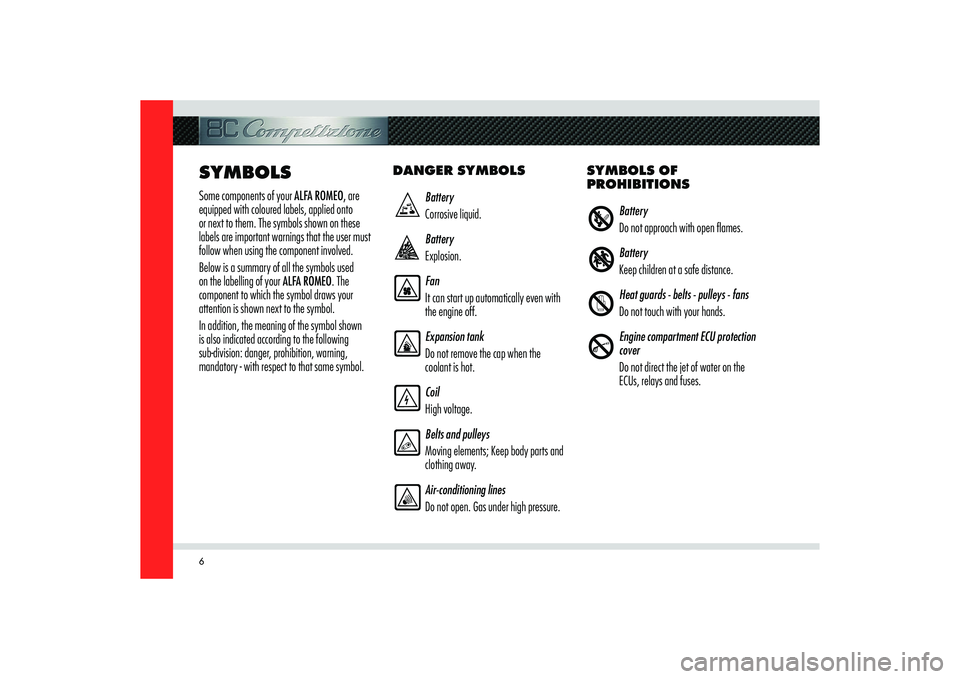
6SYMBOLSSome components of your ALFA ROMEO, are
equipped with coloured labels, applied onto
or next to them. The symbols shown on these
labels are important warnings that the user must
follow when using the component involved.
Below is a summary of all the symbols used
on the labelling of your ALFA ROMEO. The
component to which the symbol draws your
attention is shown next to the symbol.
In addition, the meaning of the symbol shown
is also indicated according to the following
sub-division: danger, prohibition, warning,
mandatory - with respect to that same symbol.DANGER SYMBOLS
Battery
Corrosive liquid.
Battery
Explosion.
Fan
It can start up automatically even with
the engine off.
Expansion tank
Do not remove the cap when the
coolant is hot.
Coil
High voltage.
Belts and pulleys
Moving elements; Keep body parts and
clothing away.
Air-conditioning lines
Do not open. Gas under high pressure.SYMBOLS OF
PROHIBITIONS
Battery
Do not approach with open fl ames.
Battery
Keep children at a safe distance.
Heat guards - belts - pulleys - fans
Do not touch with your hands.
Engine compartment ECU protection
cover
Do not direct the jet of water on the
ECUs, relays and fuses.
Page 31 of 223
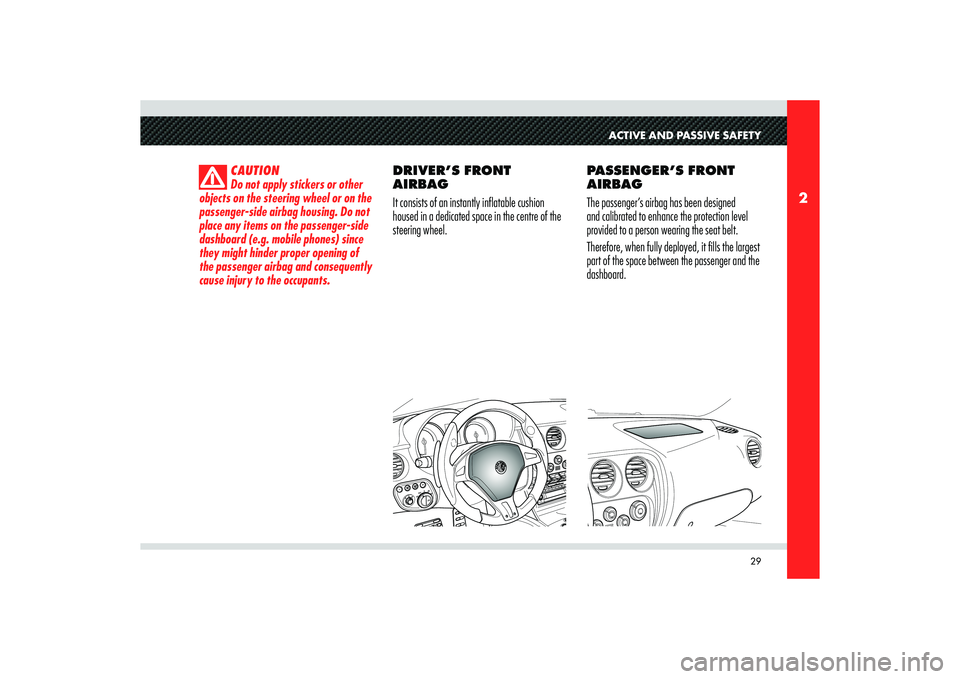
29
2
ACTIVE AND PASSIVE SAFETY
CAUTION
Do not apply stickers or other
objects on the steering wheel or on the
passenger-side airbag housing. Do not
place any items on the passenger-side
dashboard (e.g. mobile phones) since
they might hinder proper opening of
the passenger airbag and consequently
cause injury to the occupants.
DRIVER’S FRONT
AIRBAG
It consists of an instantly inflatable cushion
housed in a dedicated space in the centre of the
steering wheel.PASSENGER’S FRONT
AIRBAG
The passenger’s airbag has been designed
and calibrated to enhance the protection level
provided to a person wearing the seat belt.
Therefore, when fully deployed, it fills the largest
part of the space between the passenger and the
dashboard.
Page 32 of 223
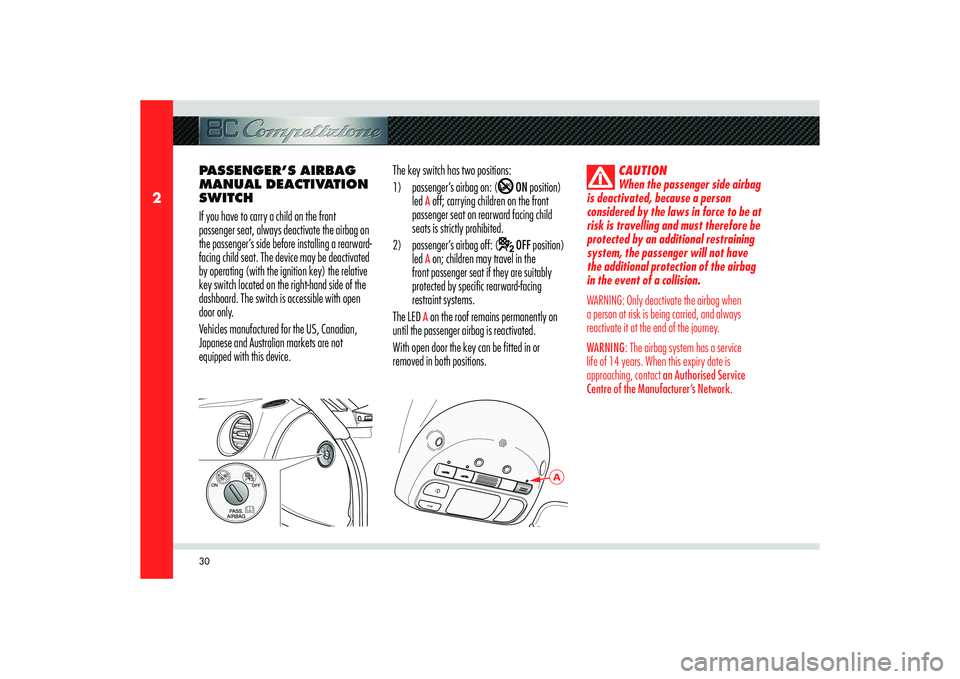
30
2
A
PASSENGER’S AIRBAG
MANUAL DEACTIVATION
SWITCH
If you have to carry a child on the front
passenger seat, always deactivate the airbag on
the passenger’s side before installing a rearward-
facing child seat. The device may be deactivated
by operating (with the ignition key) the relative
key switch located on the right-hand side of the
dashboard. The switch is accessible with open
door only.
Vehicles manufactured for the US, Canadian,
Japanese and Australian markets are not
equipped with this device.The key switch has two positions:
1) passenger’s airbag on: (
ON position)
led
A off; carrying children on the front
passenger seat on rearward facing child
seats is strictly prohibited.
2) passenger’s airbag off: (
OFF position)
led
A on; children may travel in the
front passenger seat if they are suitably
protected by specific rearward-facing
restraint systems.
The LED A on the roof remains permanently on
until the passenger airbag is reactivated.
With open door the key can be fitted in or
removed in both positions.
CAUTION
When the passenger side airbag
is deactivated, because a person
considered by the laws in force to be at
risk is travelling and must therefore be
protected by an additional restraining
system, the passenger will not have
the additional protection of the airbag
in the event of a collision.
WARNING: Only deactivate the airbag when
a person at risk is being carried, and always
reactivate it at the end of the journey.
WARNING: The airbag system has a service
life of 14 years. When this expiry date is
approaching, contact an Authorised Service
Centre of the Manufacturer’s Network.
Page 36 of 223
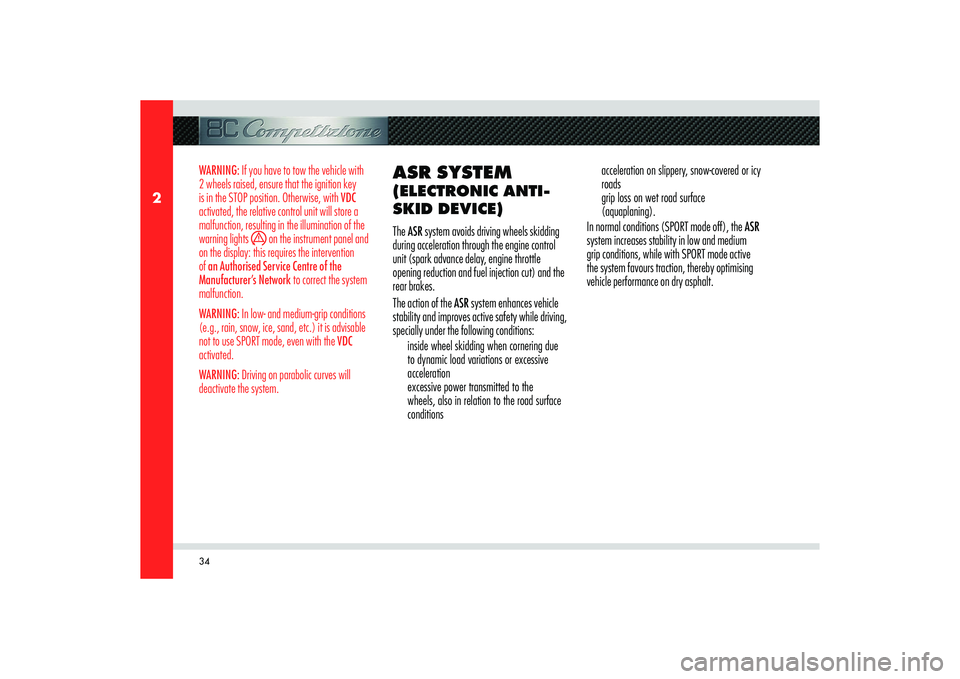
34
2
WARNING: If you have to tow the vehicle with
2 wheels raised, ensure that the ignition key
is in the STOP position. Otherwise, with VDC
activated, the relative control unit will store a
malfunction, resulting in the illumination of the
warning lights
on the instrument panel and
on the display: this requires the intervention
of an Authorised Service Centre of the
Manufacturer’s Network to correct the system
malfunction.
WARNING: In low- and medium-grip conditions
(e.g., rain, snow, ice, sand, etc.) it is advisable
not to use SPORT mode, even with the VDC
activated.
WARNING: Driving on parabolic curves will
deactivate the system.
ASR SYSTEM (ELECTRONIC ANTI-
SKID DEVICE)The ASR system avoids driving wheels skidding
during acceleration through the engine control
unit (spark advance delay, engine throttle
opening reduction and fuel injection cut) and the
rear brakes.
The action of the ASR system enhances vehicle
stability and improves active safety while driving,
specially under the following conditions:
inside wheel skidding when cornering due
to dynamic load variations or excessive
acceleration
excessive power transmitted to the
wheels, also in relation to the road surface
conditions acceleration on slippery, snow-covered or icy
roads
grip loss on wet road surface
(aquaplaning).
In normal conditions (SPORT mode off), the ASR
system increases stability in low and medium
grip conditions, while with SPORT mode active
the system favours traction, thereby optimising
vehicle performance on dry asphalt.
Page 37 of 223

35
2
A
ACTIVE AND PASSIVE SAFETY
ACTIVATION
The VDC and ASR systems are integrated in one
single function and are automatically activated
every time the engine is started; they can be
deactivated by pressing the button
A for about
1 second.
Press the button
A once again to reactivate the
systems.
The amber colour warning light
on the
instrument panel flashes during all the operating
phases.FAULT INDICATORS
In the event of a malfunction, the system
is automatically disabled and cannot be
reactivated. This condition is signalled while
driving by the amber symbol
on the display
that illuminates together with the message “ASR
failure - Go to workshop”.
MSR FUNCTION (ENGINE
BRAKING TORQUE
ADJUSTMENT)
The ASR system also controls the engine braking
torque when the accelerator pedal is released
under low grip conditions (e.g., snow, ice etc.):
in these conditions, the high braking torque of
the engine may cause instability of the vehicle.The system, using the same sensors as the ABS
system, detects the skidding of one or both
of the driving wheels when the accelerator is
released and opens the motor-driven throttle for
the engine fuel system. This reduces the braking
torque and resets the maximum grip conditions
for the driving wheels.
WARNING: However, the maximum deceleration
that can be obtained with the engine brake still
depends on the tyre grip on the road. Snow or ice
obviously reduce grip values.
Page 45 of 223
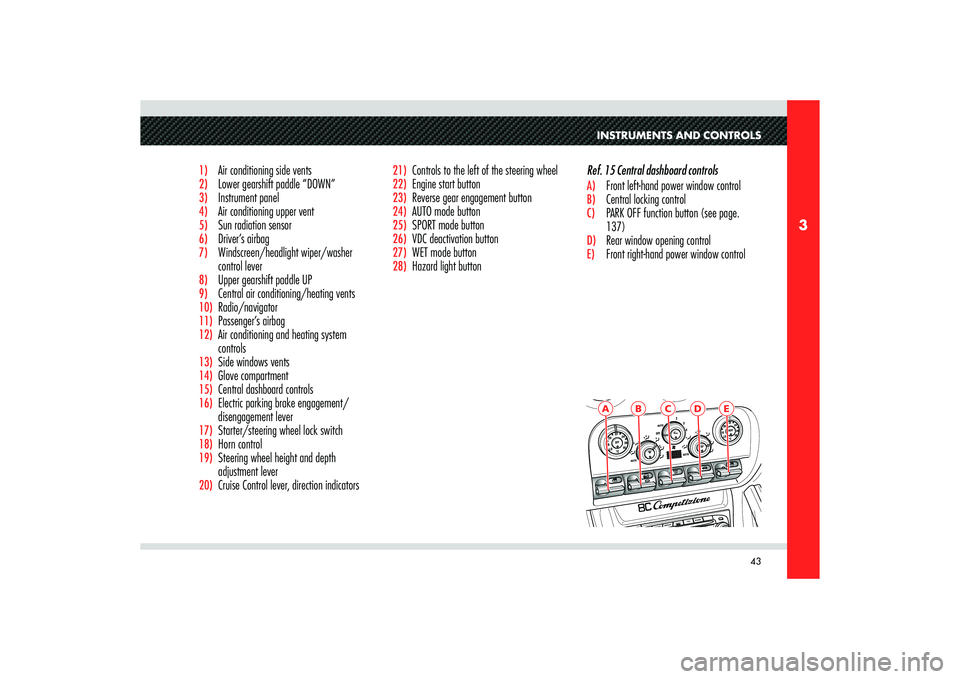
43
3
A
B
C
D
E
INSTRUMENTS AND CONTROLS
1) Air conditioning side vents2) Lower gearshift paddle “DOWN”3) Instrument panel4) Air conditioning upper vent5)
Sun radiation sensor
6)
Driver’s airbag
7)
Windscreen/headlight wiper/washer
control lever
8)
Upper gearshift paddle UP
9)
Central air conditioning/heating vents
10)
Radio/navigator
11)
Passenger’s airbag
12)
Air conditioning and heating system
controls
13)
Side windows vents
14)
Glove compartment
15)
Central dashboard controls
16)
Electric parking brake engagement/
disengagement lever
17)
Starter/steering wheel lock switch
18)
Horn control
19)
Steering wheel height and depth
adjustment lever
20)
Cruise Control lever, direction indicators
21)
Controls to the left of the steering wheel
22)
Engine start button
23)
Reverse gear engagement button
24)
AUTO mode button
25)
SPORT mode button
26)
VDC deactivation button
27)
WET mode button
28)
Hazard light buttonRef. 15 Central dashboard controls
A) Front left-hand power window controlB) Central locking control C) PARK OFF function button (see page.
137)D) Rear window opening control E) Front right-hand power window control
Page 49 of 223

47
3
INSTRUMENTS AND CONTROLS
When the key is extracted (and at least one of
the front doors is opened) the display will light
up for a few seconds, showing the Alfa Romeo
logo, the time, the total odometer and the
outside temperature. Button pressed at length:
- saves the changes confi rmed and returns
to the standard page (or the page that
was active before the MENU button was
pressed).
TRIP
Button pressed brie� y:
- activates Trip A and B pages in succession
+/-
Button pressed briefly:
- selects the functions in the Setup menu
- sets/adjusts the functions in the Setup
menu. CONTROL BUTTONS
MENU
Button pressed briefly:
- when the vehicle is stationary, it activates
the “complete” Setup menu
- when the vehicle is moving, it activates the
“reduced” Setup menu
- confi rms the selected function
- confi rms the setting/change and returns
to the main menu page (to the same item
before the button was pressed)
- if the TRIP page is displayed, it returns to
the main page.
Page 55 of 223
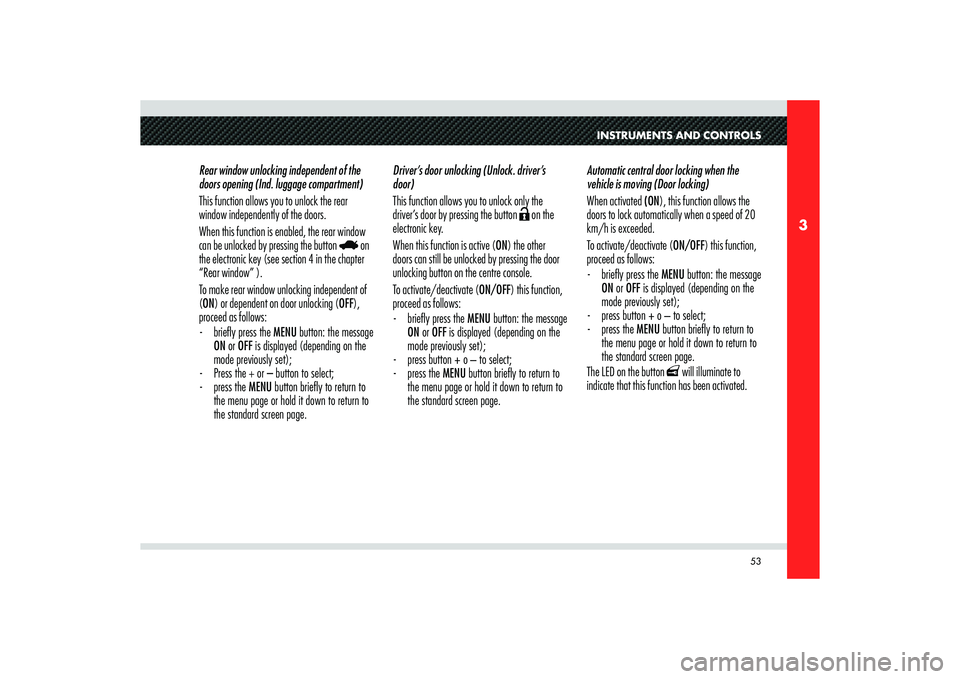
53
3
INSTRUMENTS AND CONTROLS
Rear window unlocking independent of the
doors opening (Ind. luggage compartment)
This function allows you to unlock the rear
window independently of the doors.
When this function is enabled, the rear window
can be unlocked by pressing the button
on
the electronic key (see section 4 in the chapter
“Rear window” ).
To make rear window unlocking independent of
(ON) or dependent on door unlocking (OFF),
proceed as follows:
- briefl y press the MENU button: the message
ON or OFF is displayed (depending on the
mode previously set);
- Press the + or – button to select;
- press the MENU button briefl y to return to
the menu page or hold it down to return to
the standard screen page.Driver’s door unlocking (Unlock. driver’s
door)
This function allows you to unlock only the
driver’s door by pressing the button
on the
electronic key.
When this function is active (ON) the other
doors can still be unlocked by pressing the door
unlocking button on the centre console.
To activate/deactivate (ON/OFF) this function,
proceed as follows:
- briefl y press the MENU button: the message
ON or OFF is displayed (depending on the
mode previously set);
- press button + o – to select;
- press the MENU button briefl y to return to
the menu page or hold it down to return to
the standard screen page.Automatic central door locking when the
vehicle is moving (Door locking)
When activated (ON), this function allows the
doors to lock automatically when a speed of 20
km/h is exceeded.
To activate/deactivate (ON/OFF) this function,
proceed as follows:
- briefl y press the MENU button: the message
ON or OFF is displayed (depending on the
mode previously set);
- press button + o – to select;
- press the MENU button briefl y to return to
the menu page or hold it down to return to
the standard screen page.
The LED on the button
will illuminate to
indicate that this function has been activated.
Page 56 of 223

54
3
WARNING:If the vehicle is tested on the roller
test bench without any operator on board, check
in the vehicle Setup menu that the automatic
door locking function is disabled or that a
window is open, or that there is a second key
available outside the vehicle.
Unit of Measure (Unit of Measure)
This function allows you to set the unit of
measure for the mileage (km or mi), fuel
consumption (l/100 km, km/l or mpg) and
temperature (°C or °F).
DistanceTo set the desired unit of measure, proceed as
follows:
- briefl y press the MENU button: the display
highlights “km” or “mi” (depending on
what was previously set);
- press button + or – to select;
- press the MENU button briefl y to return to
the menu page or hold it down to return to
the standard screen page.
Fuel consumption If the unit of measure for the mileage is set to
“km” (see previous chapter), you can set the
unit of measure for fuel consumption (l/100
km, km/l or mpg).
If the unit of measure for the mileage is set to
“mi” (see previous chapter), the display will
show the fuel consumption in “mpg”.
In this case, the “Fuel consumption Unit of
Measure” option in the Setup menu can be
selected but is fixed on the indication in “mpg”.
To set the desired unit of measure, proceed as
follows:
- briefl y press the MENU button: the
display highlights “km/l” or “l/100 km”
(depending on the unit was previously set);
- press button + o – to select;
- press the MENU button briefl y to return to
the menu page or hold it down to return to
the standard screen page.
Page 67 of 223
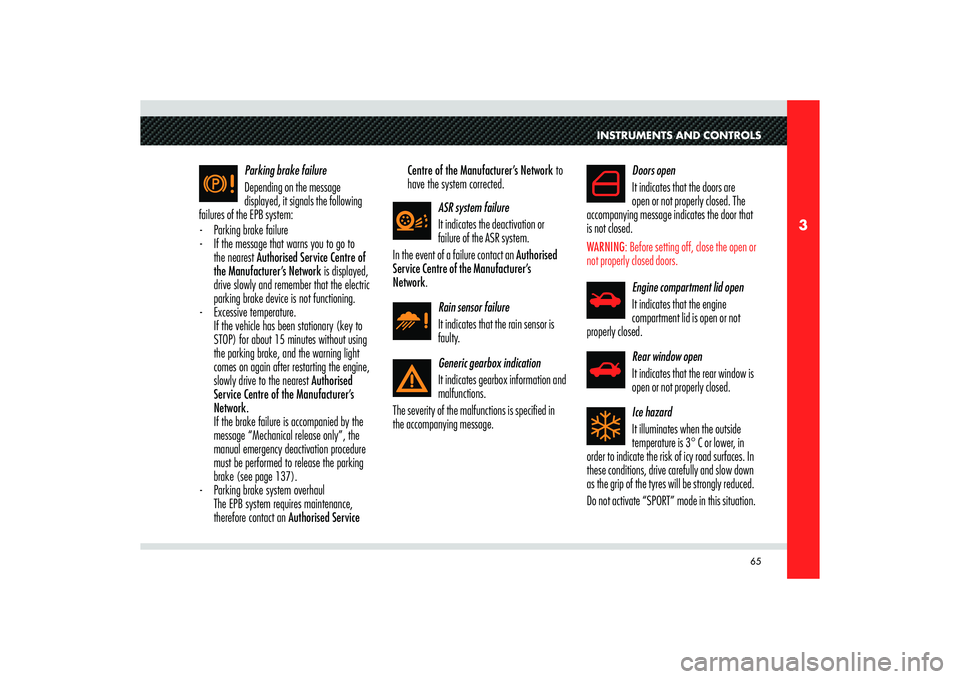
65
3
INSTRUMENTS AND CONTROLS
Parking brake failure
Depending on the message
displayed, it signals the following
failures of the EPB system:
- Parking brake failure
- If the message that warns you to go to
the nearest Authorised Service Centre of
the Manufacturer’s Network is displayed,
drive slowly and remember that the electric
parking brake device is not functioning.
- Excessive temperature.
If the vehicle has been stationary (key to
STOP) for about 15 minutes without using
the parking brake, and the warning light
comes on again after restarting the engine,
slowly drive to the nearest Authorised
Service Centre of the Manufacturer’s
Network.
If the brake failure is accompanied by the
message “Mechanical release only”, the
manual emergency deactivation procedure
must be performed to release the parking
brake (see page 137).
- Parking brake system overhaul
The EPB system requires maintenance,
therefore contact an Authorised Service Centre of the Manufacturer’s Network to
have the system corrected.
ASR system failure
It indicates the deactivation or
failure of the ASR system.
In the event of a failure contact an Authorised
Service Centre of the Manufacturer’s
Network.
Rain sensor failure
It indicates that the rain sensor is
faulty.
Generic gearbox indication
It indicates gearbox information and
malfunctions.
The severity of the malfunctions is specified in
the accompanying message.Doors open
It indicates that the doors are
open or not properly closed. The
accompanying message indicates the door that
is not closed.
WARNING: Before setting off, close the open or
not properly closed doors.
Engine compartment lid open
It indicates that the engine
compartment lid is open or not
properly closed.
Rear window open
It indicates that the rear window is
open or not properly closed.
Ice hazard
It illuminates when the outside
temperature is 3° C or lower, in
order to indicate the risk of icy road surfaces. In
these conditions, drive carefully and slow down
as the grip of the tyres will be strongly reduced.
Do not activate “SPORT” mode in this situation.